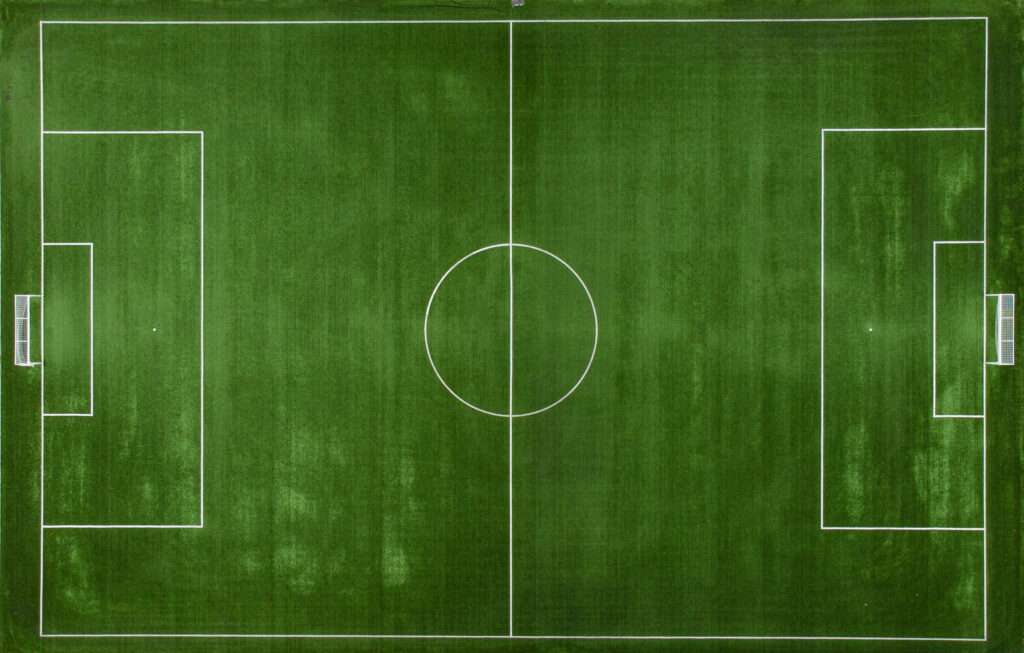Understanding the Dimensions – The Anatomy of a Football Field
Football, a sport deeply ingrained in the fabric of global culture, finds its epicenter on the iconic gridiron-the football field. Understanding the Dimensions of the Football field is fundamental for players, coaches, and fans alike. In this exploration, we unravel the lengths, widths, and areas that define the playing surface of this beloved sport.

How Long is a Football Field?
At the heart of every touchdown and every remarkable play lies the length of the football field. A standard football field, from end zone to end zone, measures 100 yards. This uniformity holds true across various levels of play, from the professional spectacle of the NFL to the fields of high schools and colleges. The consistent length ensures a level playing field, quite literally, for teams across different competitions.
Feet and Yards: Demystifying Football Field Measurements
Breaking down the 100-yard expanse, we delve into the dual measurements of feet and yards. A football field is 300 feet in length, emphasizing the scale of this vast arena. Simultaneously, the 100 yards equals to 300 feet, providing players and enthusiasts with a tangible sense of the field’s scope. Understanding these measurements is pivotal, creating a shared language for football enthusiasts to discuss the game’s dynamics.
The Width of a Football Field
While length sets the stage, the width of the football field is equally crucial. The standard width is 160 feet, contributing to the strategic dimensions of the game. The width ensures that teams have ample space to execute their plays while emphasizing the importance of lateral movement and field coverage. This dimension adds depth to the intricate dance between offense and defense on the gridiron.
Beyond Dimensions: How Big is a Football Field in Acres?
To truly appreciate the scale of a football field, we consider its size in acres. The field’s total area encompasses 1.32 acres, a figure that may surprise those who haven’t contemplated the vastness of this playing surface. To put it in perspective, a football field’s size is roughly equivalent to 1.5 international soccer fields or nearly 78,000 square yards.
FAQs about the Football Field Dimensions:
Q-1: How long is a football field?
Answer: A standard football field measures 100 yards, providing the consistent playing surface essential for various levels of play, from high school to the NFL.
Q-2: How many feet and yards make up a football field?
Answer: A football field is 300 feet in length and consists of 100 yards. This dual measurement system ensures a universal understanding of the field’s dimensions.
Q-3: What is the width of a football field?
Answer: The width of a football field is standardized at 160 feet. This dimension contributes to the strategic dynamics of the game, allowing for lateral movement and effective field coverage.
Q-4: How big is a football field in acres?
Answer: A football field’s total area is 1.32 acres. This figure provides a perspective on the expansive playing surface, equivalent to approximately 78,000 square yards or 1.5 international soccer fields.
Q-5: Why is the length of a football field standardized?
Answer: Standardizing the length of a football field at 100 yards ensures fairness and consistency across different levels of play. It provides a level playing field for teams competing in various competitions.
Q-6: Does the width of a football field vary in different leagues?
Answer: No, the width of a football field is standardized at 160 feet across all levels of play. This consistency ensures that teams have uniform dimensions to execute their plays.
Q-7: How does the size of a football field compare to other sports fields?
Answer: A football field’s size, at 1.32 acres, is relatively large. It is comparable to 1.5 international soccer fields, highlighting the significant playing area required for the unique dynamics of American football.
Q-8: Why is it important to understand football field dimensions?
Answer: Understanding football field dimensions is crucial for players, coaches, and fans. It provides a common language for discussing the game, enhances strategic insights, and contributes to a deeper appreciation of the sport’s dynamics.
Q-9: Can football field dimensions change at different venues?
Answer: While there can be slight variations in field conditions, the dimensions of a football field, including length and width, are standardized to maintain consistency and fairness in the game.
Q-10: How does the width of a football field impact gameplay?
Answer: The standardized width of 160 feet influences gameplay by providing teams with strategic opportunities for lateral movement. It contributes to the dynamic interplay between offense and defense on the gridiron.
In the world of football, the field is not just a backdrop, it’s an essential character in every game. The standardization of dimensions, from length to width and acres, ensures a universal platform for the sport’s rich narratives to unfold. Whether you’re a seasoned player, an avid fan, or a casual observer, appreciating the anatomy of a football field enhances the overall enjoyment and understanding of this thrilling game. So, as the teams clash and touchdowns unfold, take a moment to envision the intricacies of the gridiron beneath the players’ every stride.

